My #NerdAlert Pilgrimage to the Roman Ruins of Pompeii, Italy
I’m a big supporter of Doing What You Want when traveling: of seeing and doing things that you like rather than feeling obligated to mark things off your guidebook’s Top 10 Must-See list. You end up enjoying your travels the most when you focus on the things that interest you—even if that means skipping an “unmissable” sight somewhere else.
I say all this to say…I went to the ruined Roman city of Pompeii in December because I am the biggest nerd ever. Pompeii may not be an obscure or unique place to visit when compared with others that Italy has to offer, but when I made my “Grand Tour” of Italy over Christmas Break, I passed over Venice (which is typically considered an essential stop, and which I had zero desire to visit) in favor of Pompeii, a place I’ve dreamed for years of seeing one day in person.
I’ve had this urge to go on a pilgrimage to this well-preserved Roman town ever since middle school, when I began studying the “dead” language of Latin. All the way through high school, I took Latin for my foreign language credit, translating countless sentences, chanting declension endings, and holding on for dear life when we got to the pluperfect subjunctive (you don’t even wanna know).
My school used the Cambridge Latin Course curriculum, which didn’t just focus on the grammatical meat and potatoes like many books do, but also shared cultural and historical tidbits about the Roman Empire, from how the military was organized to the importance of garum fish paste in ancient cooking. What’s more, the readings in each chapter weren’t random, context-less passages but narratives that followed a handful of characters as they went about their daily lives.
My beginners Latin book introduced me to Pompeii resident Caecilius (pronounced “kai-KEE-lee-oos”), a banker who existed in real life, and his fictional son Quintus. The series begins with the sentence, Caecilius est in horto (“Caecilius is in the garden”) and from there, we get to know his family, the servants, and ancient Roman life. The book ends rather morbidly with the volcano Mt. Vesuvius erupting in 79 CE, which (spoiler alert) kills Caecilius and forces his son Quintus to flee to the island of Britannia.
Throughout this first book, the cultural sections explained how roads were paved and graded, how floors in the public baths were heated, and how Pompeii was discovered—complete with scary pictures of skeletons and plaster casts frozen in time. I always found it super interesting how much was left of the city, as if it were a time capsule with a “Don’t Open For 15 Centuries” tag on it.
So it really should come as no surprise at all that probably the highlight of my Italy trip was hiking up Mt. Vesuvius and crawling around the streets and houses of Pompeii.
Because of recent rains in the Campania region, I was afraid I wouldn’t be able to go up Mt. Vesuvius. However, the skies were mostly clear when I got off the Circumvesuviana commuter train at the Pompeii-Scavi station. There to greet us hordes of tourists were several private bus companies: Vesuvius was on!
I and four other young backpackers crammed into a simple minivan, handed over 20€ each to an old Italian man who spoke no English, and buckled up. But he was no slowpoke grandpa; this guy was all over the road, cruising at 70 km/h in a 30 zone, flying around slower traffic, honking upon approaching every curve of a switchback, the whole package. A bit nerve-wracking, for sure, but we made it from the train station all the way up to the base of the summit trail in half an hour—not bad!
A steep hike along gray and pale red volcanic gravel brought me up to the misty, foggy summit of the volcano’s crater. Although not the same abyss as the one that blew its top almost 2,000 years ago, the crater nevertheless had steam rising from its ashen sides and violent-looking boulders embedded in its walls. They say Vesuvius is overdue for an eruption (it was last active in 1944), so I went up there with a healthy amount of awe that the sheer planetary power of the volcano could decide to ignite at any second.
From the top, I took in a glorious view of the Bay of Naples, with Naples proper sprawling out to the northwest, dozens of suburbs squeezing between the coastline and the foothills of the volcano, and finally the peninsula of Sorrento that reaches out to the Isle of Capri, which floats mystically beyond in the Mediterranean.
Back at the ground level, I descended into Roman Pompeii, that is, I entered into a now-dead city that has changed very little since it was destroyed by the volcanic eruption of 79 CE. Popping on some headphones, I hit “play” on my iPod’s Rick Steves podcast app and began strolling around the still-paved streets. Almost immediately, I was struck by a triplet of round stepping stones that crossed the road, linking one curb with another. Rick Steves pointed out in his trademark folksy manner that every morning the authorities would flood the streets to keep them clean. The stepping stones allowed residents to hop from one sidewalk to another without getting their feet all wet and dirty, and the standard width between the stones let carts and chariots pass through during the rest of the day. This forward-thinking feature was a brilliant introduction to daily life in Pompeii.
Hidden inside a storage closet, which had been retrofitted into what was once the fish market, were dozens of ceramic amphorae or long, two-handled jars used to store wine, olive oil, or grain. It was almost as if the people in charge of the archaeological site were like, “uh, we don’t know what to do with these priceless examples of Roman pottery, so we’ll stuff them in this cell here.” Truly an embarrassment of riches. Although the amphorae today are rather dusty and some are cracked and broken, they’re still in marvelous condition and an example of something that was used in everyday Roman life.
I was most struck, however, by the little restaurants whose bars still stood almost fully intact with haphazard marble surfaces. Cut into these countertops were concave serving bowls for whatever it was that ancient Pompeiians had for lunch. More than anything else, seeing—and touching—the remains of these restaurants really transported me back in time: I imagined a tavern-keeper busily serving up bowls of grub in the middle of the three-sided bar, with toga-clad residents reclining against the counter jabbering away in who knows what dialect of Vulgar Latin.
I got goosebumps when I looked down at a certain stretch of lumpy stone street to see grooves that had been worn down by cart wheels over decades of use. As if the half-collapsed houses and human plaster casts weren’t evidence enough, these grooves in the road were undeniable proof that people actually lived here a long time ago.
My biggest #NerdAlert moment came when I peeked into the “House of the Tragic Poet” and looked down to see an (un)welcome mat. Some exquisitely preserved mosaics showed a vibrant black-and-white dog with a red collar around its neck. Beneath the dog’s feet were written CAVE CANEM, Latin for “Beware of Dog.” Back in junior high Latin class, I remember seeing on the wall a lower grade’s art project that depicted this very mosaic and always thought it was curious that even Romans separated from us by two millennia shared the concept of a guard dog…and the concept of posting signs to make it clear those dogs existed.
I also came across this incredibly well-preserved home that I could gaze into from the street and see an inner courtyard, domestic shrine, wall murals, windows, and doors complete with wooden lintels. The courtyard mosaics looked like they only needed a little sweeping, and with a little sprucing up any of those rooms would have been indistinguishable from a modern rustic country bungalow. This house had been spared the ravages of time by being buried in feet of dirt and ash; when I entered the now-excavated structure I almost felt like I was intruding on someone’s home, as if a family had left to run errands with the dinner still cooking.
I’ve been to many Roman ruins all over Spain, but none have been as well-preserved or felt so human as Pompeii did. Places like Itálica and Mérida were either too sparse or too monumental, but Pompeii really gave me a look into the normal, everyday life of an ancient Roman.
Have you ever been to Pompeii before? What other places make you feel that eerie connection to the past? Comment below!

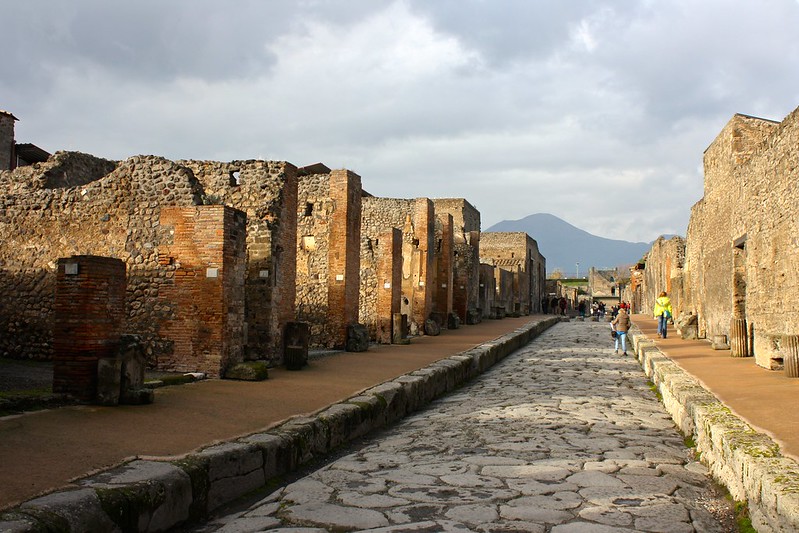
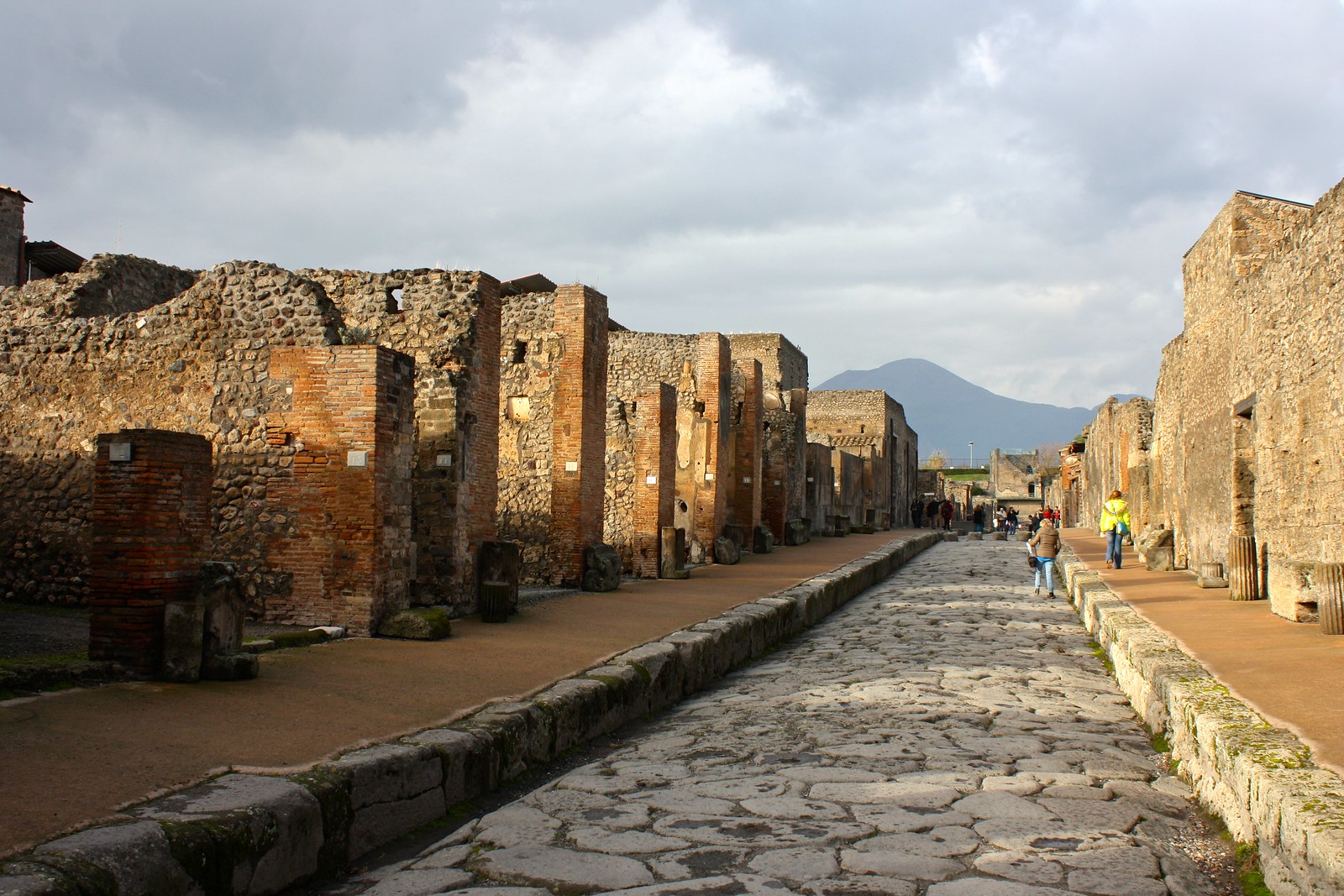 |
| Roman road |
I say all this to say…I went to the ruined Roman city of Pompeii in December because I am the biggest nerd ever. Pompeii may not be an obscure or unique place to visit when compared with others that Italy has to offer, but when I made my “Grand Tour” of Italy over Christmas Break, I passed over Venice (which is typically considered an essential stop, and which I had zero desire to visit) in favor of Pompeii, a place I’ve dreamed for years of seeing one day in person.
Studying Latin and learning about Pompeii
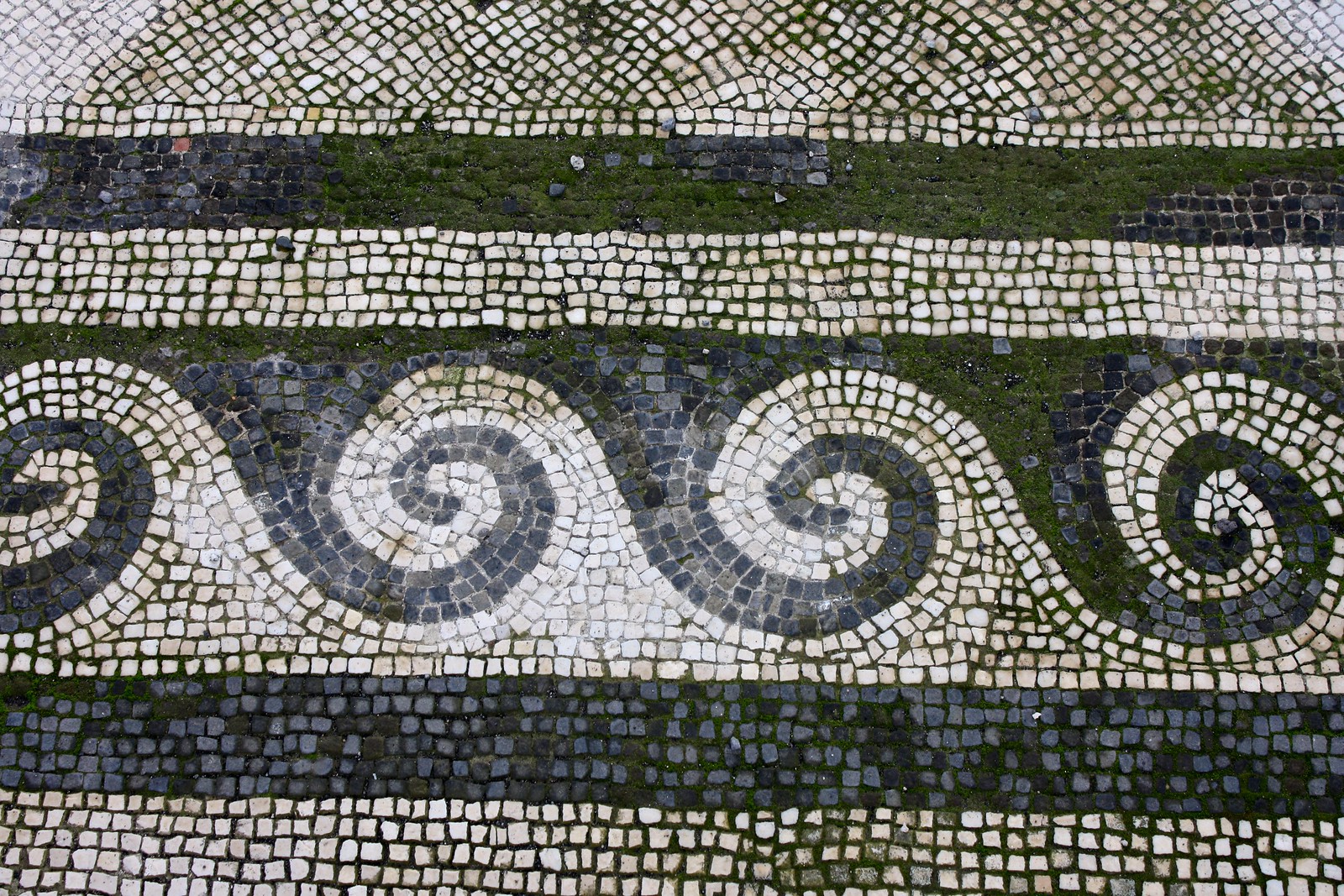 |
| Wave mosaics |
I’ve had this urge to go on a pilgrimage to this well-preserved Roman town ever since middle school, when I began studying the “dead” language of Latin. All the way through high school, I took Latin for my foreign language credit, translating countless sentences, chanting declension endings, and holding on for dear life when we got to the pluperfect subjunctive (you don’t even wanna know).
My school used the Cambridge Latin Course curriculum, which didn’t just focus on the grammatical meat and potatoes like many books do, but also shared cultural and historical tidbits about the Roman Empire, from how the military was organized to the importance of garum fish paste in ancient cooking. What’s more, the readings in each chapter weren’t random, context-less passages but narratives that followed a handful of characters as they went about their daily lives.
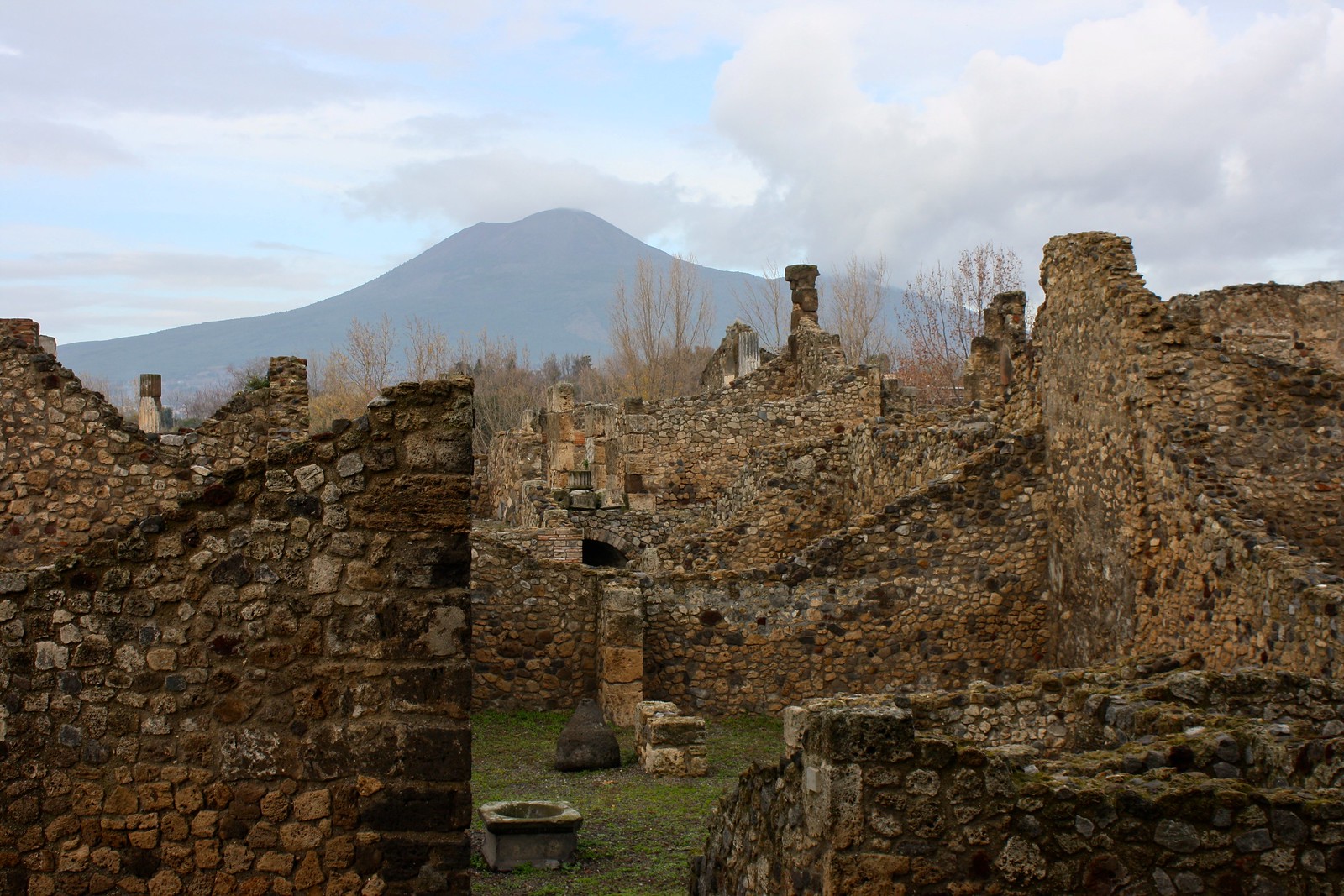 |
| Ruined homes with Mt. Vesuvius in the distance |
My beginners Latin book introduced me to Pompeii resident Caecilius (pronounced “kai-KEE-lee-oos”), a banker who existed in real life, and his fictional son Quintus. The series begins with the sentence, Caecilius est in horto (“Caecilius is in the garden”) and from there, we get to know his family, the servants, and ancient Roman life. The book ends rather morbidly with the volcano Mt. Vesuvius erupting in 79 CE, which (spoiler alert) kills Caecilius and forces his son Quintus to flee to the island of Britannia.
Throughout this first book, the cultural sections explained how roads were paved and graded, how floors in the public baths were heated, and how Pompeii was discovered—complete with scary pictures of skeletons and plaster casts frozen in time. I always found it super interesting how much was left of the city, as if it were a time capsule with a “Don’t Open For 15 Centuries” tag on it.
 |
| Brick columns in disguise as marble ones |
So it really should come as no surprise at all that probably the highlight of my Italy trip was hiking up Mt. Vesuvius and crawling around the streets and houses of Pompeii.
Ascending the crater of Vesuvius
 |
| At the crater |
Because of recent rains in the Campania region, I was afraid I wouldn’t be able to go up Mt. Vesuvius. However, the skies were mostly clear when I got off the Circumvesuviana commuter train at the Pompeii-Scavi station. There to greet us hordes of tourists were several private bus companies: Vesuvius was on!
 |
| Rugged cone layers |
I and four other young backpackers crammed into a simple minivan, handed over 20€ each to an old Italian man who spoke no English, and buckled up. But he was no slowpoke grandpa; this guy was all over the road, cruising at 70 km/h in a 30 zone, flying around slower traffic, honking upon approaching every curve of a switchback, the whole package. A bit nerve-wracking, for sure, but we made it from the train station all the way up to the base of the summit trail in half an hour—not bad!
 |
| Bay of Naples |
A steep hike along gray and pale red volcanic gravel brought me up to the misty, foggy summit of the volcano’s crater. Although not the same abyss as the one that blew its top almost 2,000 years ago, the crater nevertheless had steam rising from its ashen sides and violent-looking boulders embedded in its walls. They say Vesuvius is overdue for an eruption (it was last active in 1944), so I went up there with a healthy amount of awe that the sheer planetary power of the volcano could decide to ignite at any second.
From the top, I took in a glorious view of the Bay of Naples, with Naples proper sprawling out to the northwest, dozens of suburbs squeezing between the coastline and the foothills of the volcano, and finally the peninsula of Sorrento that reaches out to the Isle of Capri, which floats mystically beyond in the Mediterranean.
Nerding-out in Pompeii
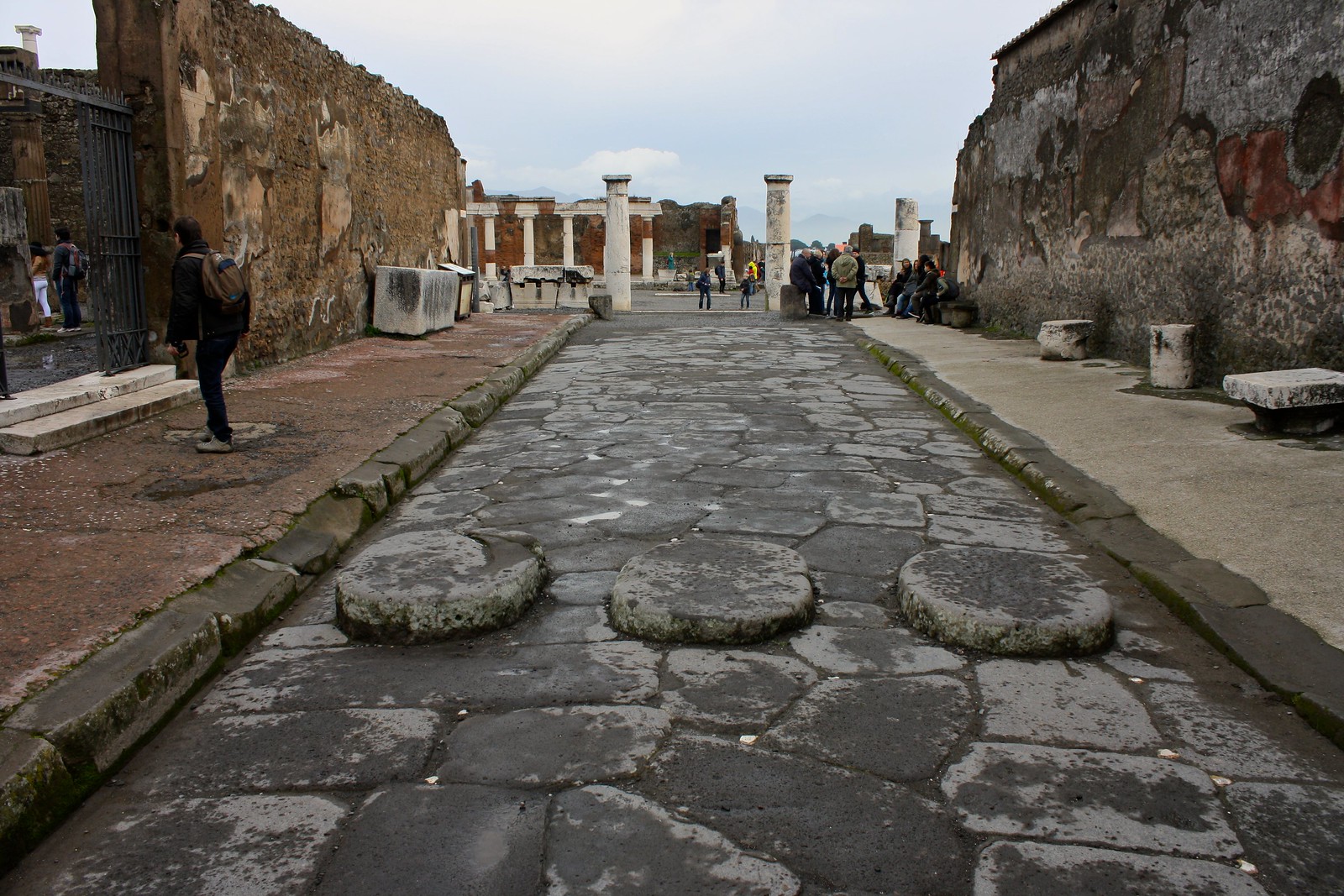 |
| Stepping stones to cross the daily-flooded streets |
Back at the ground level, I descended into Roman Pompeii, that is, I entered into a now-dead city that has changed very little since it was destroyed by the volcanic eruption of 79 CE. Popping on some headphones, I hit “play” on my iPod’s Rick Steves podcast app and began strolling around the still-paved streets. Almost immediately, I was struck by a triplet of round stepping stones that crossed the road, linking one curb with another. Rick Steves pointed out in his trademark folksy manner that every morning the authorities would flood the streets to keep them clean. The stepping stones allowed residents to hop from one sidewalk to another without getting their feet all wet and dirty, and the standard width between the stones let carts and chariots pass through during the rest of the day. This forward-thinking feature was a brilliant introduction to daily life in Pompeii.
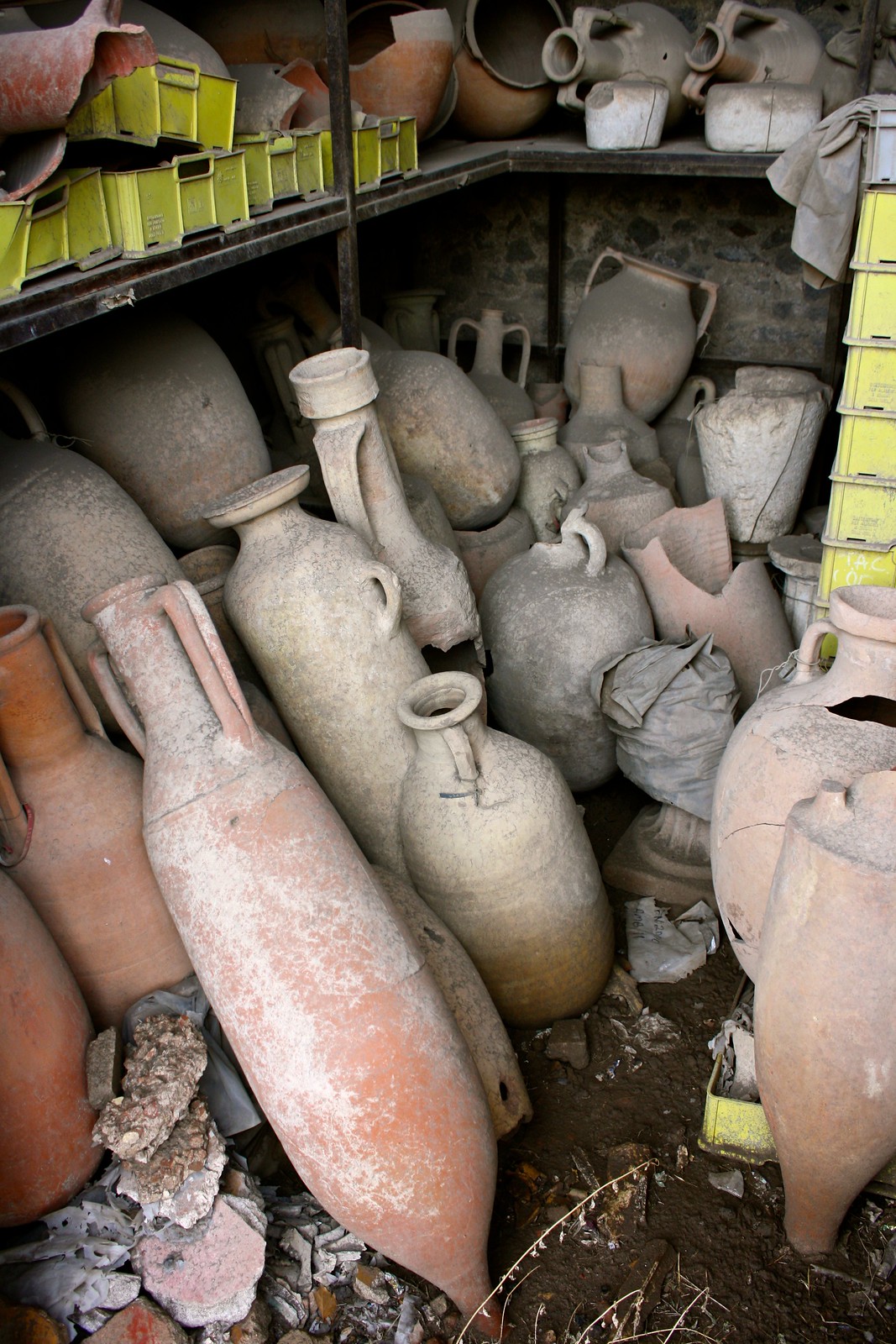 |
| Tons of amphorae in storage |
Hidden inside a storage closet, which had been retrofitted into what was once the fish market, were dozens of ceramic amphorae or long, two-handled jars used to store wine, olive oil, or grain. It was almost as if the people in charge of the archaeological site were like, “uh, we don’t know what to do with these priceless examples of Roman pottery, so we’ll stuff them in this cell here.” Truly an embarrassment of riches. Although the amphorae today are rather dusty and some are cracked and broken, they’re still in marvelous condition and an example of something that was used in everyday Roman life.
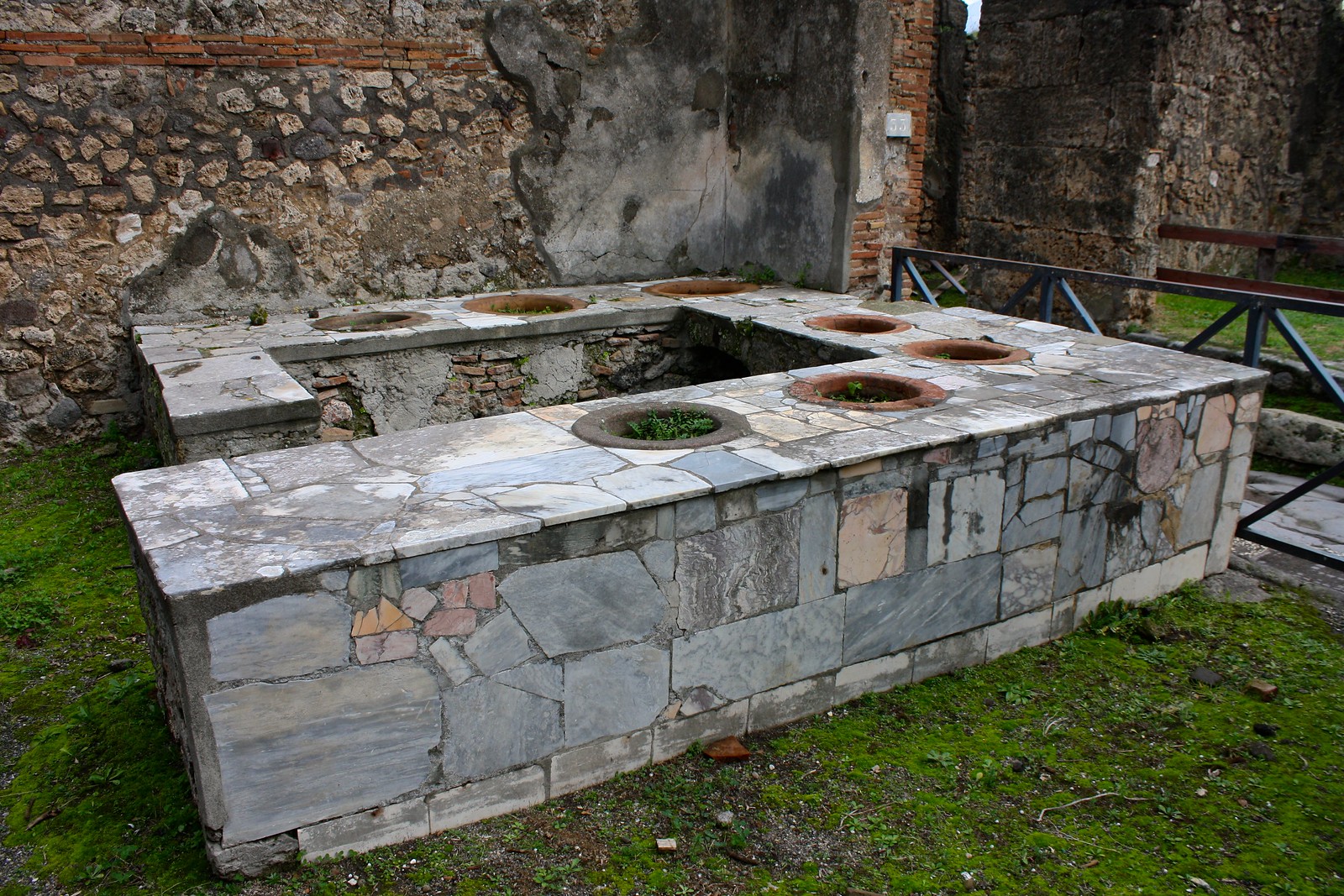 |
| Where you got your Pompeiian bar food at |
I was most struck, however, by the little restaurants whose bars still stood almost fully intact with haphazard marble surfaces. Cut into these countertops were concave serving bowls for whatever it was that ancient Pompeiians had for lunch. More than anything else, seeing—and touching—the remains of these restaurants really transported me back in time: I imagined a tavern-keeper busily serving up bowls of grub in the middle of the three-sided bar, with toga-clad residents reclining against the counter jabbering away in who knows what dialect of Vulgar Latin.
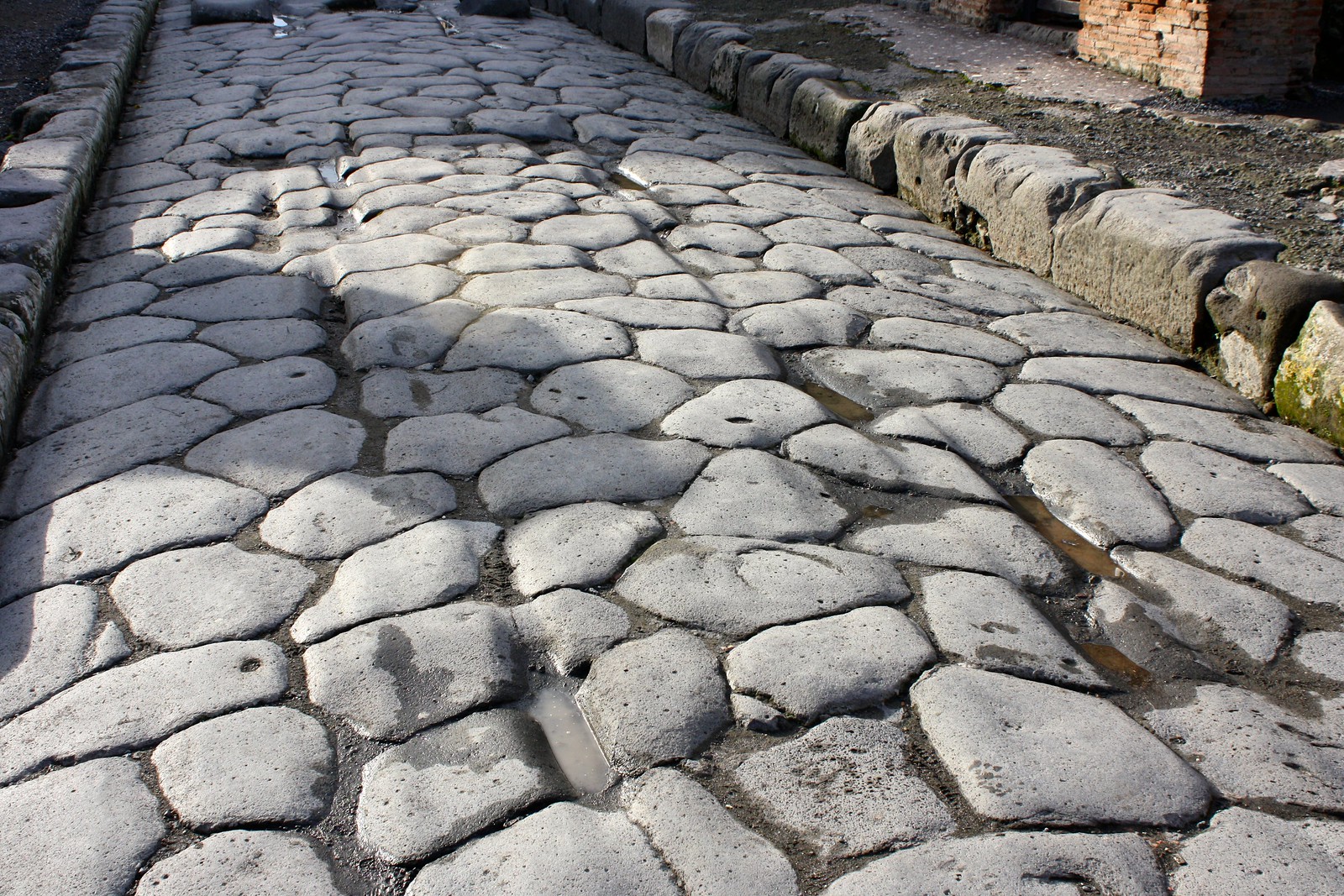 |
| Grooves from cart and chariot wheels |
I got goosebumps when I looked down at a certain stretch of lumpy stone street to see grooves that had been worn down by cart wheels over decades of use. As if the half-collapsed houses and human plaster casts weren’t evidence enough, these grooves in the road were undeniable proof that people actually lived here a long time ago.
 |
| Cave Canem—Beware of Dog |
My biggest #NerdAlert moment came when I peeked into the “House of the Tragic Poet” and looked down to see an (un)welcome mat. Some exquisitely preserved mosaics showed a vibrant black-and-white dog with a red collar around its neck. Beneath the dog’s feet were written CAVE CANEM, Latin for “Beware of Dog.” Back in junior high Latin class, I remember seeing on the wall a lower grade’s art project that depicted this very mosaic and always thought it was curious that even Romans separated from us by two millennia shared the concept of a guard dog…and the concept of posting signs to make it clear those dogs existed.
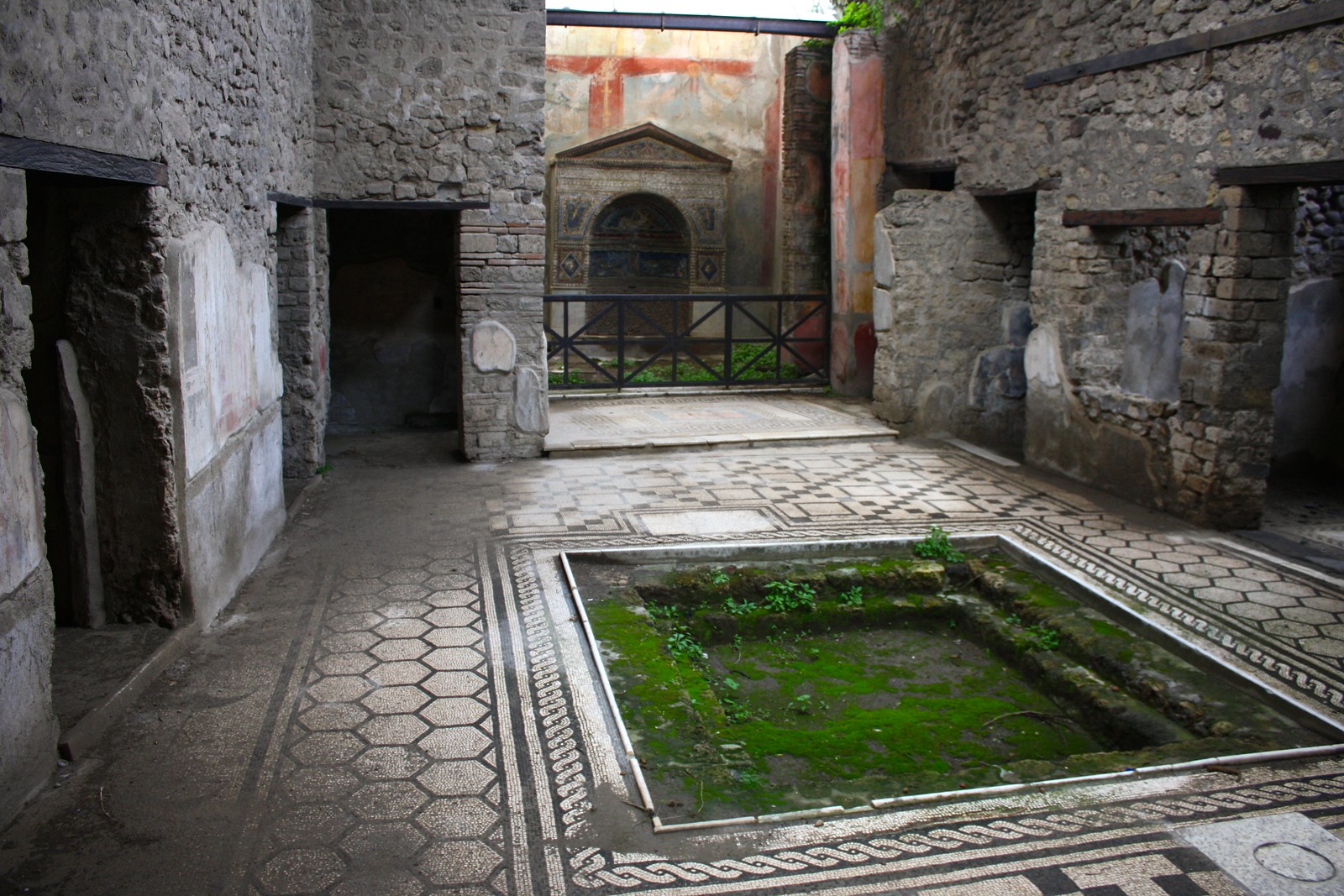 |
| Interior house courtyard |
I also came across this incredibly well-preserved home that I could gaze into from the street and see an inner courtyard, domestic shrine, wall murals, windows, and doors complete with wooden lintels. The courtyard mosaics looked like they only needed a little sweeping, and with a little sprucing up any of those rooms would have been indistinguishable from a modern rustic country bungalow. This house had been spared the ravages of time by being buried in feet of dirt and ash; when I entered the now-excavated structure I almost felt like I was intruding on someone’s home, as if a family had left to run errands with the dinner still cooking.
I’ve been to many Roman ruins all over Spain, but none have been as well-preserved or felt so human as Pompeii did. Places like Itálica and Mérida were either too sparse or too monumental, but Pompeii really gave me a look into the normal, everyday life of an ancient Roman.
Have you ever been to Pompeii before? What other places make you feel that eerie connection to the past? Comment below!

